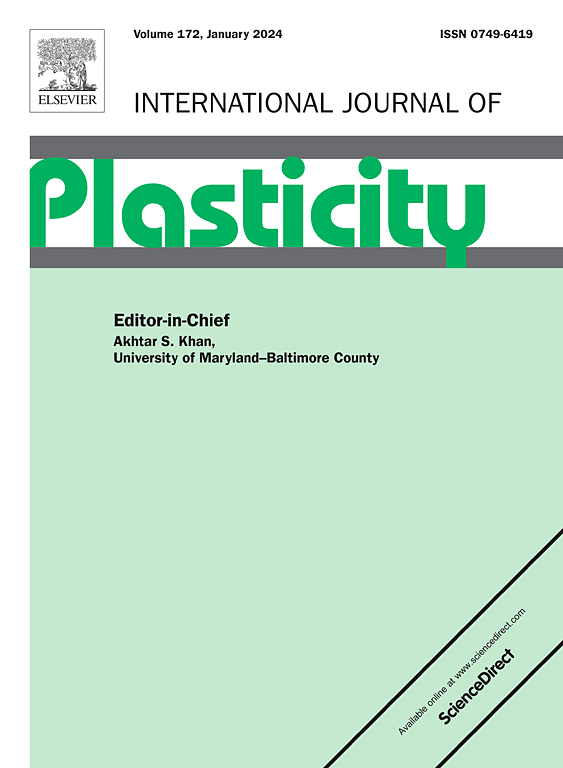高熵合金中结构软化介导的剪切带
IF 9.4
1区 材料科学
Q1 ENGINEERING, MECHANICAL
引用次数: 0
摘要
塑性流动局部化是金属材料中普遍存在的一种基本非平衡现象。尽管经过数十年的广泛研究,但其产生的原因仍然难以捉摸。在此,我们采用新开发的斜坡波压缩技术,在面心立方(fcc)Cantor 合金中解决了这一问题,该技术提供了独特的准各向同性加载路径。通过详细的微观结构表征、温度增量的分析估算和大规模原子模拟,我们得出结论:热软化并不是剪切带形成的先决条件。相反,纳米扭转引发了最初的转变软化,随后伴随着剧烈的化学波动和低角度位错边界(LADB)的产生,相邻区域的局部位错滑移增强。这种低角位错边界反过来又会导致定向软化,成为相邻纳米晶丝之间变形的催化剂。因此,纳米晶簇和 LADB 之间的相互连接被视为剪切带的结构起源,而动态再结晶仅在剪切带演化过程的后期发生,从而加速了应变的定位和剪切带的增厚。这些发现为从根本上理解金属材料的剪切带和动态失效机制提供了新的思路。本文章由计算机程序翻译,如有差异,请以英文原文为准。
Structural softening mediated shear bands in high entropy alloys
Plastic flow localization is a fundamental and ubiquitous non-equilibrium phenomenon in metallic materials. Despite decades of extensive study, what derives its emergence remains elusive. Here, we tackle this problem in face-centered cubic (fcc) Cantor alloy by the newly developed ramp wave compression technique, which provides a unique quasi-isentropic loading path. By detailed microstructure characterizations, analytical estimation of temperature increment and large-scale atomistic simulations, we conclude that thermal softening is not a dominant driving force for shear band nucleation. Instead, nanotwinning triggers the initial transformation softening which is then accompanied with severe chemical fluctuations and the creation of low-angle dislocation boundaries (LADBs) associated with enhanced local dislocation slips in the adjacent regions. Such LADBs in turn lead to directional softening, acting as the catalytic mediating distortion between neighboring nanotwins. The interconnection between nanotwins and LADBs is thus regarded as structural origin of shear bands, whereas dynamic recrystallization only occurs later during shear band evolution, accelerating strain localization and thickening shear band. These findings shed new lights into fundamental understanding of shear banding and dynamic failure mechanisms in metallic materials.
求助全文
通过发布文献求助,成功后即可免费获取论文全文。
去求助
来源期刊

International Journal of Plasticity
工程技术-材料科学:综合
CiteScore
15.30
自引率
26.50%
发文量
256
审稿时长
46 days
期刊介绍:
International Journal of Plasticity aims to present original research encompassing all facets of plastic deformation, damage, and fracture behavior in both isotropic and anisotropic solids. This includes exploring the thermodynamics of plasticity and fracture, continuum theory, and macroscopic as well as microscopic phenomena.
Topics of interest span the plastic behavior of single crystals and polycrystalline metals, ceramics, rocks, soils, composites, nanocrystalline and microelectronics materials, shape memory alloys, ferroelectric ceramics, thin films, and polymers. Additionally, the journal covers plasticity aspects of failure and fracture mechanics. Contributions involving significant experimental, numerical, or theoretical advancements that enhance the understanding of the plastic behavior of solids are particularly valued. Papers addressing the modeling of finite nonlinear elastic deformation, bearing similarities to the modeling of plastic deformation, are also welcomed.
 求助内容:
求助内容: 应助结果提醒方式:
应助结果提醒方式:


